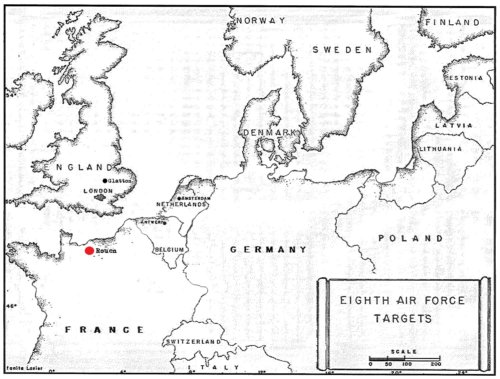TARGET: OIL DUMP
ROUEN, FRANCE
22 JUNE, 1944

The striking power of the Eighth Air Force was directed back to tactical targets; 800 bombers were dispatched against power installations, communications lines, airfields and oil depots. The 457th attacked oil dumps in France. The target was on the south bank of the Seine River across from the City of Rouen. It had not been attacked before.
The 457th supplied two 12 ship boxes for the mission. Lt. Louis 0. Mueller was Air Commander of the lead B box, with Lt. Kenneth R. Johnston as pilot. Major Eugene Peresich was Commander of the low B box, with Lt. Harry Stafford as pilot.
The route to the target was again over the invasion coast. The entire Normandy beachhead was visible. Bombing results were good, in spite of the fact that the lead bombardier, Lt. Harry G. Vaal, was hit in the eye by splintered glass from the plexiglass nose due to a flak hit on the bomb run. Flak was heavy and accurate with fifteen craft damaged.
One aircraft was piloted by Lt. Franklin H. Morrell. He brought it back to England, and prepared for a crash landing, without brakes. When he touched down, the plane veered off to the right, hitting the wing of another aircraft, and then crashed head-on into a parked aircraft. Both caught fire immediately and were completely consumed by flames, shooting two and three hundred feet into the air. Fifty caliber shells were exploding; projectiles and pieces of metal flew through the air. Flares were going off continually and the heat was terrific. Miraculously the entire crew escaped.
Lt. Eugene F. Tangherlini, an assistant engineering officer with the 749th, and Sgt. Herbert B. Mayers, a flight chief, raced to the scene. The wing of the first ship to be hit, before the head- on collision, was actually overlapped the fuselage of one of the burning ships. Lt. Tangherlini knew that the ship had to be moved without delay. He further realized that the gas tanks were partially filled, and that if a fire did develop, the ship would explode. Despite the difficulties encountered and the danger involved, Lt. Tangherlini and Sgt. Mayers succeeded in moving the ship a safe distance from the fire. After this was accomplished, the two men returned to the scene of the fire and repeated the performance by moving another Fortress away from the flames. It was found later that the wing on the first ship to be taxied away had actually begun to melt. Because of the courage and devotion to duty displayed by Lt. Tangherlini and Sgt. Mayers, both were decorated with the Bronze Star medal for the heroism displayed.
Sgt. James H. Denny of the 468th Sub Depot also witnessed the crash. He grabbed a half track and raced to the scene. Upon arriving be opened the door of the crashed bomber to permit the crew to escape. He then tied the half track to the tail of the craft and pulled it away from the other craft. For the heroism he displayed, he was awarded the Soldier’s medal.
(Compilers Note: Jim Denny relates that Sgt. James W Vaughn, also with the 468th Sub Depot, was involved with the rescue and was also awarded the Soldier’s medal.)

